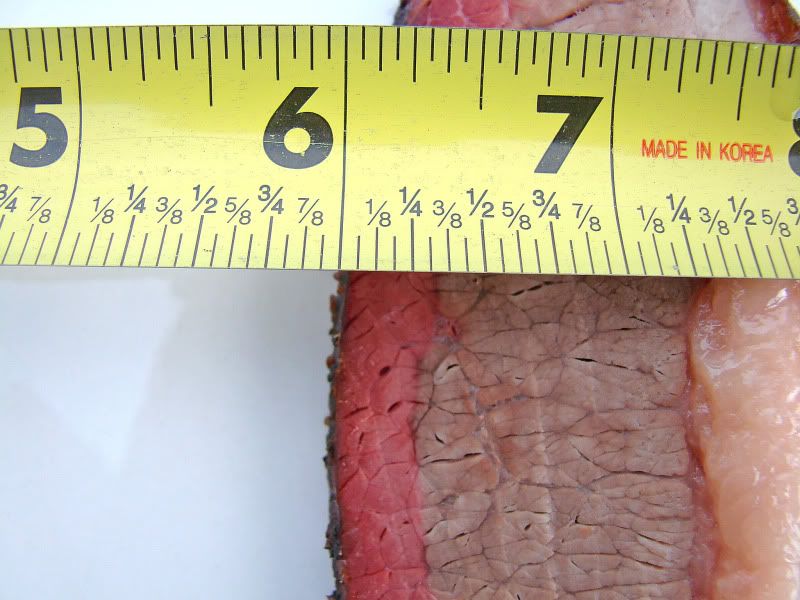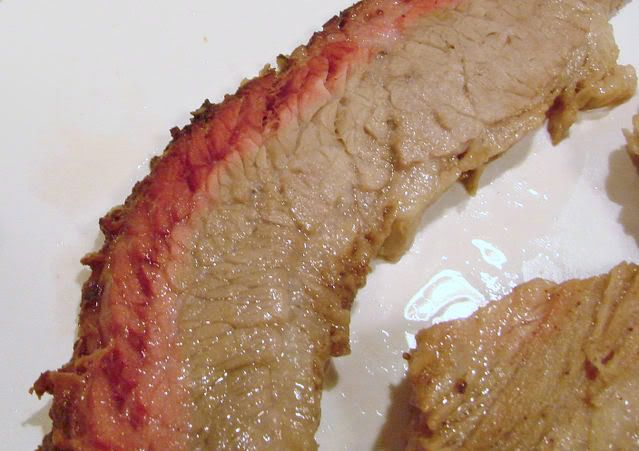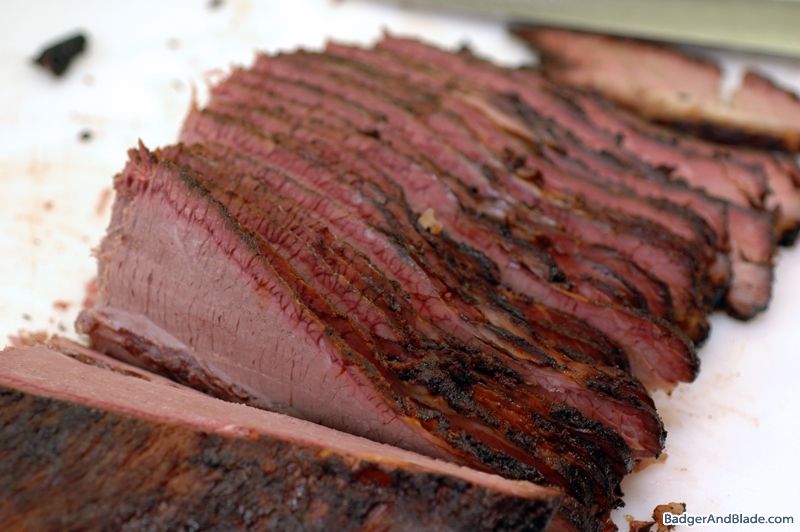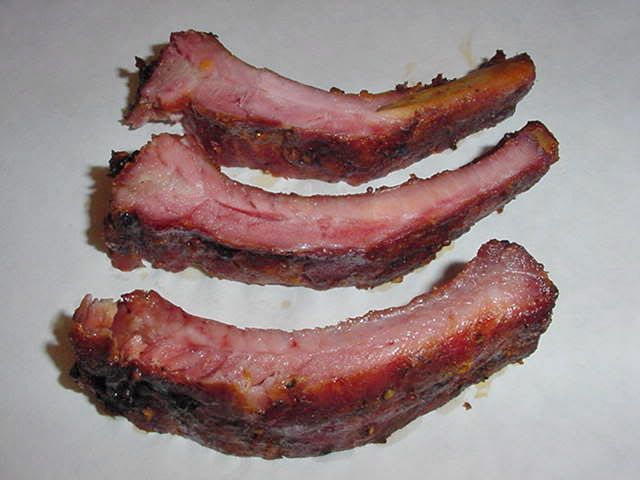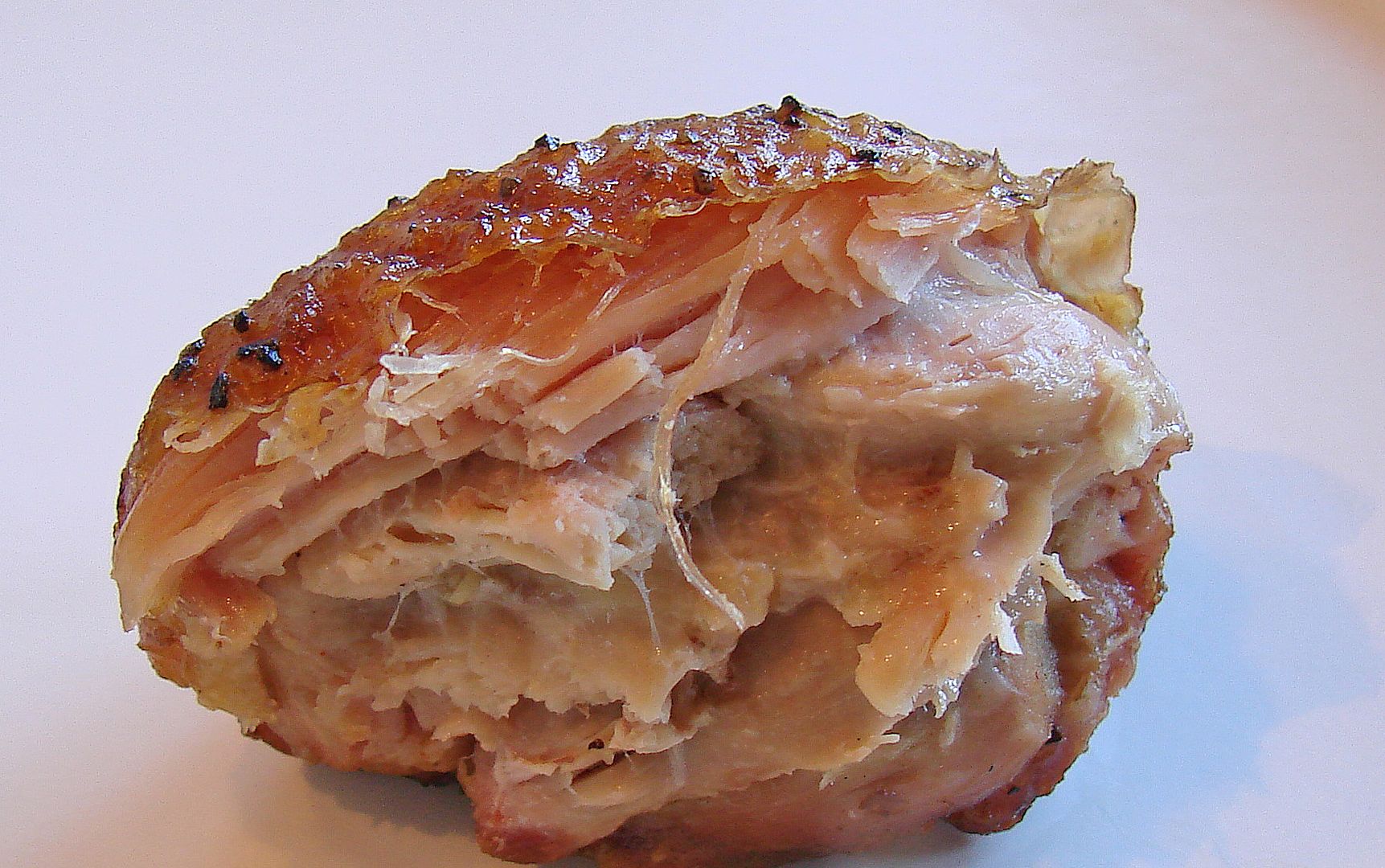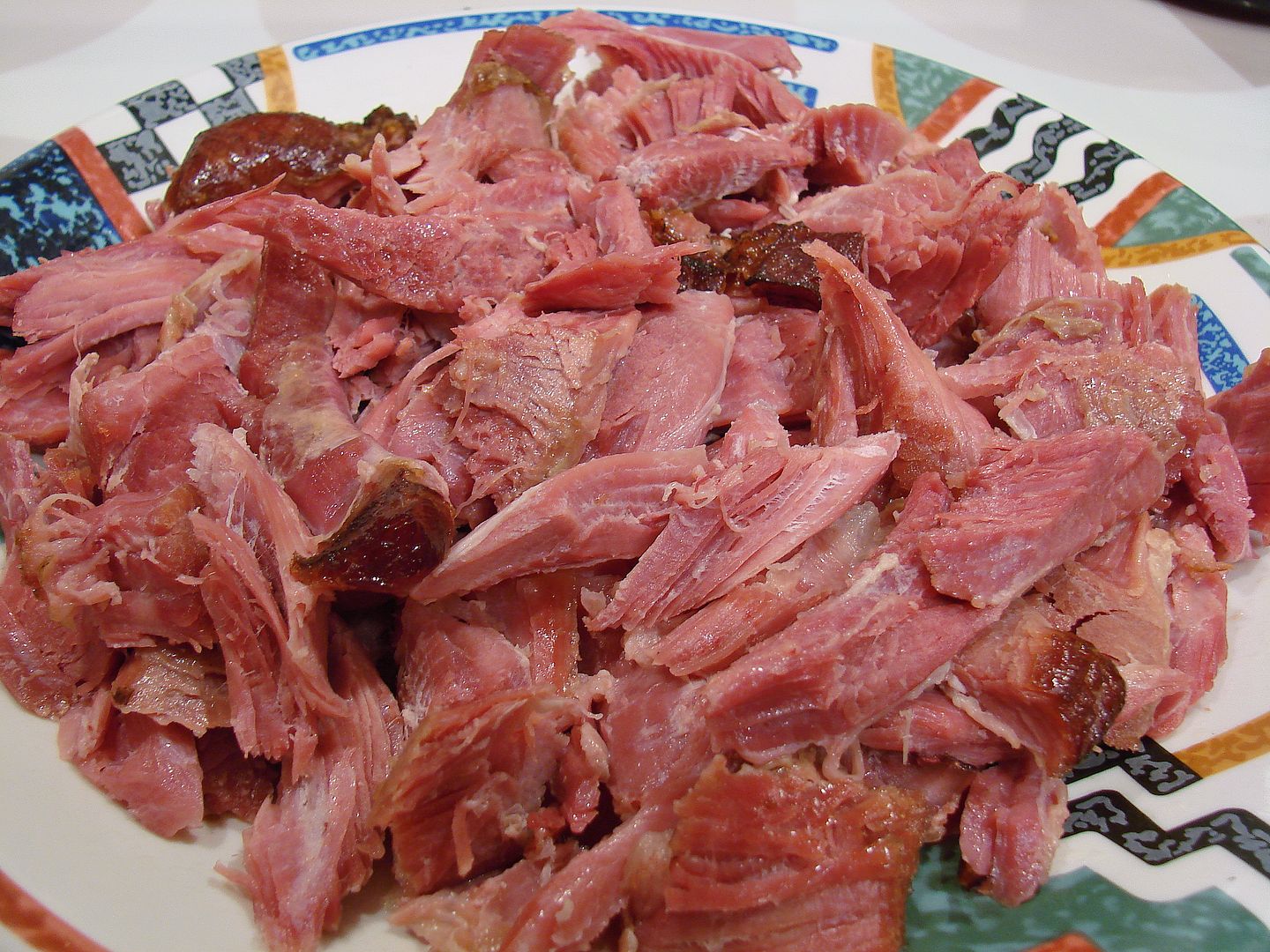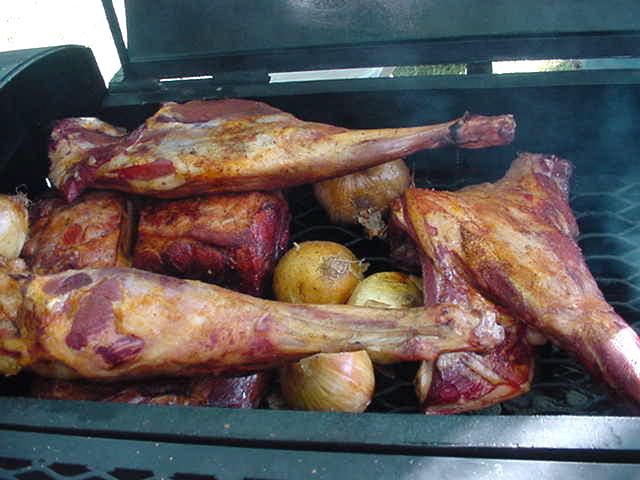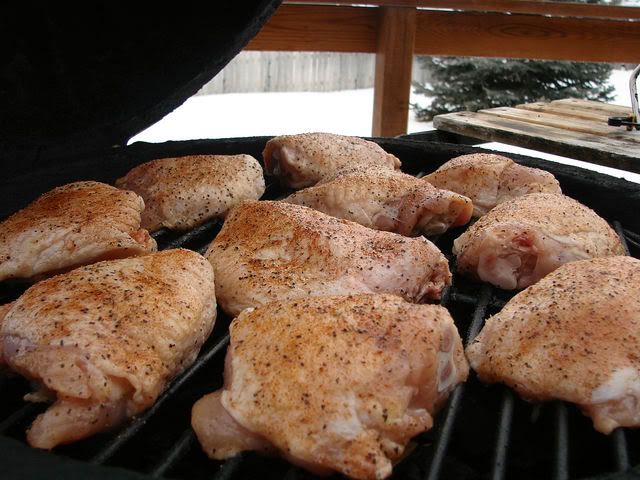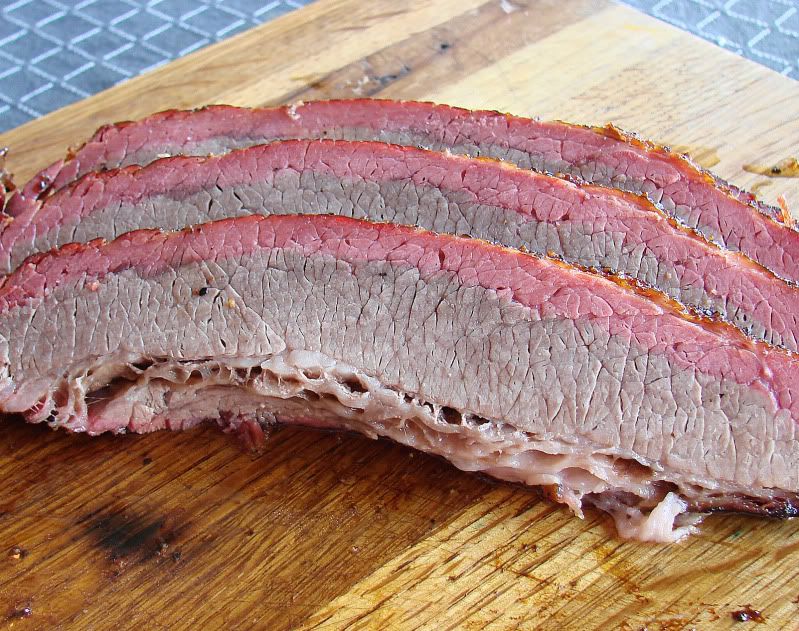Okay, you might want to refill your glass, make a trip to the fridge, or get another cup of coffee. Here is a clip from my cookin' site that is sub titled "Smoke Rings, What Are They and How Do I Get One"..... It's in my typical long winded style. Just remember, you asked for it.
There is a lot of bragging when it comes to smoke rings. Sometimes it's the pit bosses that are showing them off, and sometimes they don't say a word and wait for folks to notice on their own...... When I serve up some brisket or folks see a photograph of my brisket with a nice ring it's the first thing they notice. They say things like "Boy, that sombitch sure knows his barbecue, look at that smoke ring". Let's face it, a good smoke ring is the sign of an accomplished cook that understands meat, heat, time, wood and his cooker. Right? ..... Well, those things sure help. It also helps if you know a little about science.
So, what is a smoke ring anyway? Well, when the conditions are right, slow cooked barbecued meats exhibit a band of color around the outer edge. These bands are called smoke rings, and they can be 1/8" to 1/2" wide. The color can range from light pink to deep red. Sometimes they are actually mistaken for undercooked meat.
Smoke rings are one of the most misunderstood and one of the most sought after things in barbecue. For starters, a smoke ring is NOT caused from smoke that has penetrated and colored the meat. Smoke rings are formed when gases in the smoke interact with myoglobin. "My what??" one guy exclaimed during a discussion about smoke rings at a local tavern. Myoglobin is the pigment that gives muscle its color. Beef muscle has more pigment than pork muscle so beef has a darker color than pork. Pork loin is lighter in color than a pork shank or picnic. Chicken thighs have a darker color than chicken breasts. This is all because of the amount of myoglobin in each muscle.
Okay, here is the deal.... Most of us use wood in the forms of chips, pellets, chunks or even logs to generate smoke when cooking. Wood contains large amounts of nitrogen. When wood burns, the nitrogen combines with oxygen in the air to form nitrogen dioxide. Nitrogen dioxide is highly water-soluble and early in the cook, it's absorbed into the surface of the meat and forms nitrous acid. The nitrous acid travels inward and creates a colored smoke ring. Smoke rings are usually pink, but the myoglobin in the meat can produce a darker red ring. Have you ever wondered why ham, bacon or corned beef has a different color than fresh muscle meat? That's because the chemicals sodium nitrate and sodium nitrite are added to salt and used to cure those products. In the old days we used potassium nitrate (aka saltpeter) to cure and preserve meats. So, should we really call them nitrogen rings? Let's not go that far, but at least we know how a smoke ring is formed.
Because I barbecue my prime rib roasts, I will even get a narrow ring on them from time to time.
The smoke ring doesn't always have to be in the form of a ring. Take a pork rib for example... they are so thin that sometimes the full thickness of the meat takes the color.
Thighs and drumsticks are another example. When the pigments in the meat turn pink from the effects of the nitrogen reaction, some folks think the meat is undercooked. The internal temperature of this boneless thigh was 180° when I took it off the smoker. It is thoroughly cooked.
Here is some meat from a smoked turkey leg. This was brined with some tenderquick so it has both a deep pink color and a ham-like texture. The point here is, it hardly resembles poultry.
Now I'm going to explain about smoke rings, how to get one, how to get a better one, and how to get one any time you want, even if you are cooking a brisket or some ribs in the oven (you know, that square thing in your kitchen with the clock. But first off, don't get smoke rings and smoke flavor confused. They are not as related as many folks think. You can have smokey flavored meats that don't have a smoke ring. And later I will prove that you can have a smoke ring .... without using any smoke.
* Smoke rings stop forming at 140°, so start your meat off cold, and run your pit colder for the first couple of hours. Remember that the ring formation stops around 140°, you can keep piling on the smoke flavor as long as you have smoke. (In fact you can make meat so smokey you won't want to eat it).
* Flaming wood produces more nitrogen than a smoldering fire. Use correct vent settings on your cooker, and maintain good airflow in your firebox, charcoal basket etc.
* Moist meat absorbs nitrogen dioxide more easily. Use a water pan in your cooker, use a ceramic cooker (they keep meats moister than many steel pits), marinate, inject baste, or spritz your meat, or use some immature wood. Don't use all green wood, just a piece or two that is not fully cured. Soak a few chips or a chunk or two, don't soak them all or your smoke production will be limited until the wood dries out. Try putting a whole onion or two on the grate, they release moisture curing the cook and are delicious. Look close in this picture and you will see 6 or 8 onions amongst the meat, there is also a coffee can half-full of water in the other end.
* Charcoal briquettes have more nitrogen than lump charcoal. If you are a lump burner add a couple of briquettes atop your fire early on in the cook. If you are using a box style electric or propane smoker, add a briquette or two to your chip pan.
* Cook larger cuts of meat and/or keep your cooker full.... More meat means more mass, more mass will retain more moisture. Select whole briskets over flats, cook two butts instead of one, don't just cook 3 thighs, buy a big pack and fill up that grate. If you have some spare room on a grate, put a fatty or two on.
* Use some Tenderquick. All you do is sprinkle some on the inside face of a brisket (the side opposite the fat cap) and let it sit for 10 minutes. Rinse it off, then return the brisket to the fridge for 1 hour. Then season and barbecue as usual. This is a TQ'd brisket.
Tip: Remember the wisecrack about getting a smoke ring in the oven? I TQ'd this brisket flat, wrapped it in foil and baked it in my oven at 275° for 4 hours.




